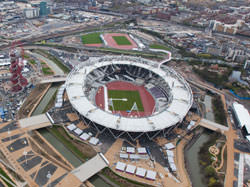

Photo courtesy of EG Focus
The 2012 London Olympic Park is taking sustainability to the next level.
Olympic Stadium sits in an area known for housing London, England’s poor and socially progressive citizens and building depravation. That all changed this year with the opening of the 2012 London Olympics, based around Olympic Park, built in this area of the city.
This world-class stadium was built with recycled gas pipes, surrounded by colorful marigolds and poppies, toilets that use rainwater collected from a venue that uses an all-natural ventilation system, and a river packed with 300,000 different types of aquatic plants. The London Games operations bureau may have created a new environmentally friendly standard for future Olympic-host cities to match or possibly improve upon.
The Daily Yomiuri Online describes how a former wasteland in East End, London, England, was transformed into a green, clean, athletic haven: “Before Olympic development began, the main greenery in the area was a nonnative species of knotweed, a tenacious plant able to thrive between cracks in old concrete roads.”
London Games Bureau operations bureau states, “It took three years to eradicate the weeds, which included torching an area the size of 11 soccer fields.”
Included in the carbon-reducing layout are: 4,000 poplar and other native trees; less steel used, which reduced carbon dioxide; purified soil, smart meters that the temporary residents of Olympic Village can watch to monitor their electricity use, a low-carbon-dioxide concrete base and recycled granite.
For more information on Olympic Stadium visit London 2012.




